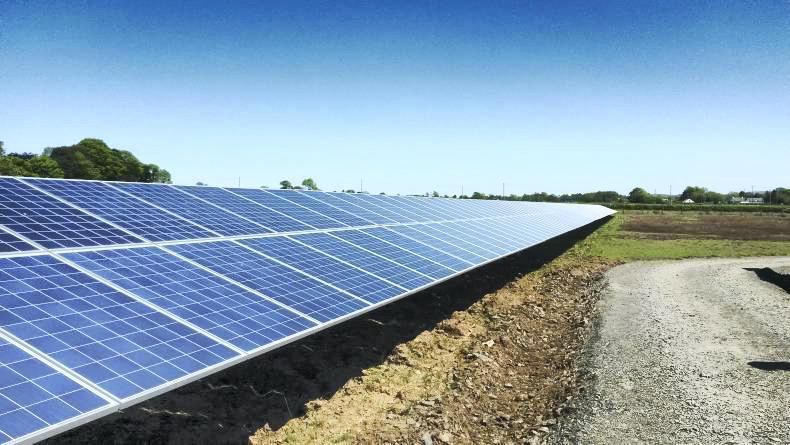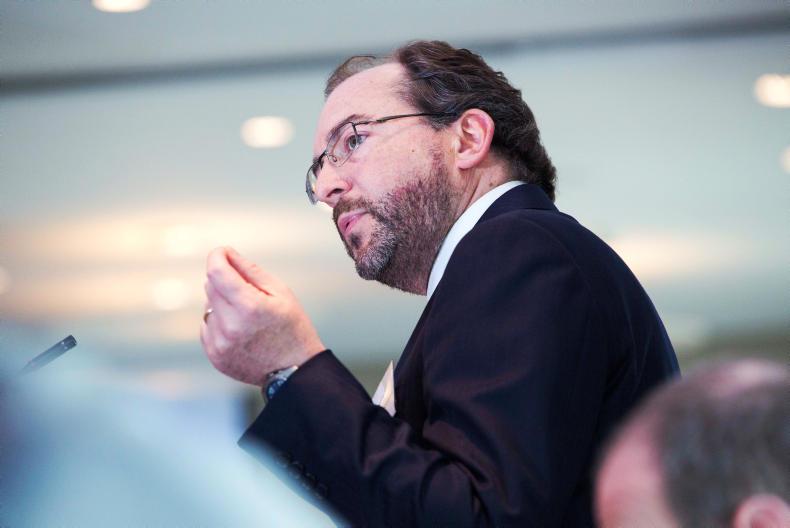Minister for Communications, Climate Action and Environment Denis Naughten told the Irish Farmers Journal this week that he intends to have a renewable energy support scheme in place by the end of this year that would include solar energy for the first time.
“My intention is to make sure that there is a broader suite of technologies used to produce renewable electricity than would have been the case up to now,” Minister Naughten said. “All eggs are pretty much in the on-shore wind turbine sector. I want to include solar, off-shore wind and other renewable sources.”
Solar photovoltaic is the cheapest form of renewable energy generation after on-shore wind in Ireland
The Government has commissioned an economic analysis of the sector, which is due to be published as part of a public consultation on the upcoming Renewable Electricity Support Scheme in the coming weeks. “I expect that this will clearly show that solar photovoltaic is the cheapest form of renewable energy generation after on-shore wind in Ireland,” David Maguire told the Irish Farmers Journal.
Although his company, BNRG, is based in Dublin, all the solar farms it has developed so far have been outside the Republic of Ireland. The exclusion of solar from past support schemes has been one of the main hurdles to the sector’s development here.
Auction-based scheme
A key decision the Government needs to make this year is how financial support will be allocated to renewable energy projects. Maguire and other developers represented by the Irish Solar Energy Association (ISEA) favour an auction system, in which companies would bid for subsidised capacity. Those able to deliver renewable electricity at the lowest cost would secure the funding. 
”Under an auction process, the market will drive the price down to deliver value,” said Maguire. “This will deliver the best value for money to the consumer and Exchequer.”
To offer a farming comparison, this is as if the GLAS scheme was run on an auction basis, with farmers competing to implement agri-environmental measures. Those committing to sowing wild bird cover or switching to low-emission slurry spreading at the lowest cost would be selected to receive matching payments.
Tillage farmer Michael Quirk, who is planning an independent solar farm on his land in Ahada, Co Cork, disagrees. “An auction-based system is a very costly system to apply for and there’s no guarantee of success,” he said. This could exclude community and farm-based projects. He would prefer to see a fixed, subsidised feed-in tariff.
Listen to an interview with Michael in our podcast below:
Listen to “Cork farmer on trying to start a solar farm” on Spreaker.
According to Maguire, the producer price required to make solar viable in Ireland is between 11c/kWh and 12c/kWh. He argued that this would be close to the support offered for wind generation in existing support schemes, which are now closed to new entrants.
BNRG is one of the companies betting on solar energy becoming profitable in Ireland in the short term. Earlier this year, Maguire announced the formation of a joint venture with French heavyweight Neoen to invest €220m in solar farms in the south and east by 2020.
“BNRG has already signed options on the majority of land required for this portfolio of projects,” Maguire said, adding that the company was continuing discussions with landowners on a number of sites. BNRG needs 1,100 acres for this investment, 95% of which will remain under grass swards mainly used to graze sheep on the company’s UK farms.
Many other developers have been approaching farmers with solar projects, and industry sources agree that not all are viable.
Grid connections
The ESB has received applications to connect around 5GW of solar power to the national grid to date, which would be equivalent to 20,000 acres of solar farms. At the latest count, an ESB spokesperson told the Irish Farmers Journal that 509 applications, totalling 3.7GW, were on a waiting list.
“I believe that there is between 1.5GW and 2GW of suitable or potential grid capacity available on the system without triggering deep reinforcement costs,” said Maguire, adding that BNRG had applied for grid connections for all the sites where it has signed options with landowners.
Of the various EU countries where BNRG has done business, Ireland is proving to be the slowest and most expensive
“I believe that over 70% of those applications will not be in a position to compete in an auction-driven process as they are simply too expensive to connect to the grid,” said Maguire. “Of the various EU countries where BNRG has done business, Ireland is proving to be the slowest and most expensive,” he added.
Minister Naughten has warned that he would not subsidise all the existing applications and cautioned against “speculative” activity in the sector.
Read more
Full coverage: renewable energy
Minister for Communications, Climate Action and Environment Denis Naughten told the Irish Farmers Journal this week that he intends to have a renewable energy support scheme in place by the end of this year that would include solar energy for the first time.
“My intention is to make sure that there is a broader suite of technologies used to produce renewable electricity than would have been the case up to now,” Minister Naughten said. “All eggs are pretty much in the on-shore wind turbine sector. I want to include solar, off-shore wind and other renewable sources.”
Solar photovoltaic is the cheapest form of renewable energy generation after on-shore wind in Ireland
The Government has commissioned an economic analysis of the sector, which is due to be published as part of a public consultation on the upcoming Renewable Electricity Support Scheme in the coming weeks. “I expect that this will clearly show that solar photovoltaic is the cheapest form of renewable energy generation after on-shore wind in Ireland,” David Maguire told the Irish Farmers Journal.
Although his company, BNRG, is based in Dublin, all the solar farms it has developed so far have been outside the Republic of Ireland. The exclusion of solar from past support schemes has been one of the main hurdles to the sector’s development here.
Auction-based scheme
A key decision the Government needs to make this year is how financial support will be allocated to renewable energy projects. Maguire and other developers represented by the Irish Solar Energy Association (ISEA) favour an auction system, in which companies would bid for subsidised capacity. Those able to deliver renewable electricity at the lowest cost would secure the funding. 
”Under an auction process, the market will drive the price down to deliver value,” said Maguire. “This will deliver the best value for money to the consumer and Exchequer.”
To offer a farming comparison, this is as if the GLAS scheme was run on an auction basis, with farmers competing to implement agri-environmental measures. Those committing to sowing wild bird cover or switching to low-emission slurry spreading at the lowest cost would be selected to receive matching payments.
Tillage farmer Michael Quirk, who is planning an independent solar farm on his land in Ahada, Co Cork, disagrees. “An auction-based system is a very costly system to apply for and there’s no guarantee of success,” he said. This could exclude community and farm-based projects. He would prefer to see a fixed, subsidised feed-in tariff.
Listen to an interview with Michael in our podcast below:
Listen to “Cork farmer on trying to start a solar farm” on Spreaker.
According to Maguire, the producer price required to make solar viable in Ireland is between 11c/kWh and 12c/kWh. He argued that this would be close to the support offered for wind generation in existing support schemes, which are now closed to new entrants.
BNRG is one of the companies betting on solar energy becoming profitable in Ireland in the short term. Earlier this year, Maguire announced the formation of a joint venture with French heavyweight Neoen to invest €220m in solar farms in the south and east by 2020.
“BNRG has already signed options on the majority of land required for this portfolio of projects,” Maguire said, adding that the company was continuing discussions with landowners on a number of sites. BNRG needs 1,100 acres for this investment, 95% of which will remain under grass swards mainly used to graze sheep on the company’s UK farms.
Many other developers have been approaching farmers with solar projects, and industry sources agree that not all are viable.
Grid connections
The ESB has received applications to connect around 5GW of solar power to the national grid to date, which would be equivalent to 20,000 acres of solar farms. At the latest count, an ESB spokesperson told the Irish Farmers Journal that 509 applications, totalling 3.7GW, were on a waiting list.
“I believe that there is between 1.5GW and 2GW of suitable or potential grid capacity available on the system without triggering deep reinforcement costs,” said Maguire, adding that BNRG had applied for grid connections for all the sites where it has signed options with landowners.
Of the various EU countries where BNRG has done business, Ireland is proving to be the slowest and most expensive
“I believe that over 70% of those applications will not be in a position to compete in an auction-driven process as they are simply too expensive to connect to the grid,” said Maguire. “Of the various EU countries where BNRG has done business, Ireland is proving to be the slowest and most expensive,” he added.
Minister Naughten has warned that he would not subsidise all the existing applications and cautioned against “speculative” activity in the sector.
Read more
Full coverage: renewable energy







 This is a subscriber-only article
This is a subscriber-only article





SHARING OPTIONS: